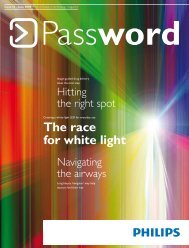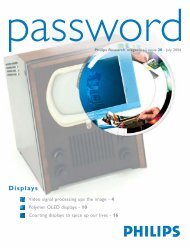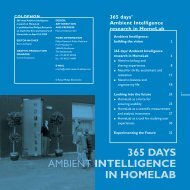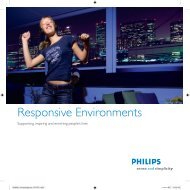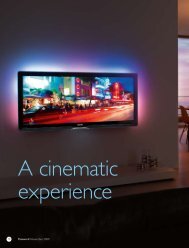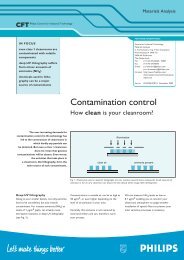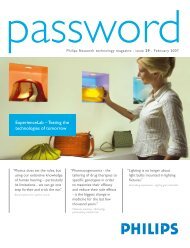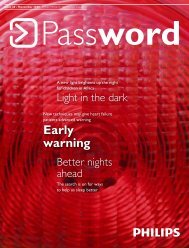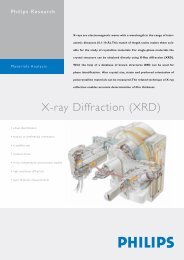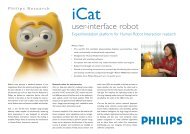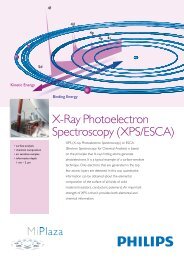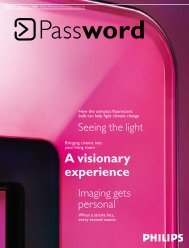article - Philips Research
article - Philips Research
article - Philips Research
You also want an ePaper? Increase the reach of your titles
YUMPU automatically turns print PDFs into web optimized ePapers that Google loves.
Double-layer LCD technology<br />
brings clarity to radiology images<br />
Scientists at <strong>Philips</strong> <strong>Research</strong> have developed an<br />
advanced double-layer LCD technology that<br />
drastically enhances the clarity and detail visible in<br />
radiology images. This technology offers patients<br />
the prospect of earlier, faster and more reliable<br />
diagnosis, improved treatment and a better<br />
prognosis. The benefi ts are expected to be<br />
particularly signifi cant in the diagnosis of diseases<br />
such as cancer (particularly breast cancer)<br />
and arteriosclerosis.<br />
Based on two LCD screens sandwiched together<br />
with intermediate polarizers and an enhanced<br />
backlighting system, <strong>Philips</strong> high-contrast dual-layer<br />
More information: www.research.philips.com/newscenter/archive/2005/051129-lcd.html<br />
LCD technology dramatically increases the<br />
displayable grey-scale range, and allows almost<br />
100% blocking of the backlight to achieve a much<br />
better black level. Coupled with the high-intensity<br />
backlighting already fi tted to FIMI <strong>Philips</strong><br />
medical-grade LCD displays, the result is a<br />
high-brightness, high-contrast display that maintains<br />
a high contrast ratio even when viewed at<br />
a very wide viewing angle. <strong>Philips</strong> <strong>Research</strong>’s<br />
demonstrator for the technology is a<br />
1.3-megapixel (1280 x 1024) 18.1-inch DICOM<br />
compatible grey-scale display with 750-cd/m2 peak<br />
brightness, 0.005-cd/m2 black level and a contrast<br />
ratio in excess of 100,000:1.<br />
New techniques for faster<br />
molecular-imaging applications<br />
<strong>Philips</strong> is currently developing fast quantitative<br />
Magnetic Resonance (MR) acquisition and<br />
data-analysis techniques for molecular-imaging<br />
applications. Evaluation of the new techniques in<br />
collaboration with luminary clinical sites, such as<br />
the University Hospital Münster, Germany, the<br />
National Institutes of Health (NIH) in Bethesda,<br />
More information: www.research.philips.com/newscenter/archive/2005/051129-mri.html<br />
What’s new What’s new<br />
USA, and the Washington University in St. Louis,<br />
USA, has shown that quantitative MRI is indeed a<br />
powerful tool for the early assessment of diseases<br />
and for monitoring the effects of therapy in<br />
follow-up studies. Moreover, by non-invasive<br />
measurements of drug effects, quantitative MRI can<br />
speed up the development and approval of drugs.<br />
Examination of an X-ray image on a<br />
high-brightness, high-contrast LCD prototype<br />
Quantitative measurement of contrast agent<br />
concentration in Magnetic Resonance Imaging<br />
(MRI)<br />
Heart modeling system speeds up<br />
cardiac care<br />
New powerful image analysis and modeling<br />
software from <strong>Philips</strong> <strong>Research</strong> to reveal detailed<br />
heart function will save cardiologists a great deal<br />
of time and effort in extracting the information<br />
they need for the accurate diagnosis of heart<br />
disorders. As a result, patients will benefi t from<br />
faster and more reliable test results, more effective<br />
and personalized therapies and speedier recovery.<br />
Using advanced image analysis techniques<br />
combined with detailed clinical knowledge about<br />
the structure and function of the human heart,<br />
scientists at <strong>Philips</strong> <strong>Research</strong> have developed an<br />
innovative cardiac modeling system that extracts<br />
a large number of morphological and physiological<br />
measurements from multi-slice CT (computed<br />
tomography) images. In more than 90% of the<br />
cases it does so entirely automatically, saving<br />
cardiologists a great deal of costly time and effort.<br />
Although <strong>Philips</strong> has used cardiac CT as an initial<br />
application and proof of concept, <strong>Philips</strong> believes<br />
that this new modeling technology will be<br />
applicable in other areas of radiology and other<br />
imaging modalities as well.<br />
More information: www.research.philips.com/newscenter/archive/2005/051129-heartmod.html<br />
<strong>Philips</strong> introduces new Blu-ray Disc<br />
products and media at CES 2006<br />
On January 4th , 2006, <strong>Philips</strong> Electronics<br />
announced the introduction of a Blu-ray Disc<br />
consumer electronic player (BDP 9000), an all-inone<br />
PC Writer (TripleWriter) and new Blu-ray<br />
media (BD-R and B-RE, single-layer 25 GB and<br />
dual-layer BD-R and BD-RE 50 GB) at the 2006<br />
Consumer Electronics Show (CES).<br />
Both the BDP9000 consumer player and the<br />
TripleWriter (SPD7000) will be available in the<br />
second half of 2006.<br />
More information: www.ces.philips.com/downloads/Blu-ray_Release.doc<br />
<strong>Philips</strong>’ new Blu-ray solutions offer consumers the<br />
ultimate storage platform for high-defi nition (HD)<br />
entertainment and digital archiving, providing consumers<br />
the ability to store massive amounts of content<br />
on a single disc. Additionally, Blu-ray Disc is the<br />
next-generation platform for HD playback of video<br />
content and is supported by more than 160 of the<br />
world’s largest gaming manufacturers, movie studios,<br />
consumer electronics and PC manufacturers.<br />
<strong>Philips</strong> researchers working with <strong>Philips</strong>’ new<br />
cardiac modeling software that automatically<br />
matches its heart model to the patient’s<br />
multi-slice CT scan, and then creates a highly<br />
detailed patient-specifi c 3D model from<br />
which a wide range of morphological and<br />
physiological measurements can be extracted.<br />
4 <strong>Philips</strong> <strong>Research</strong> Password 26 l February 2006 <strong>Philips</strong> <strong>Research</strong> Password 26 5<br />
l February 2006




